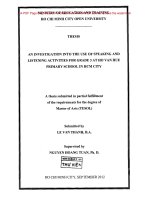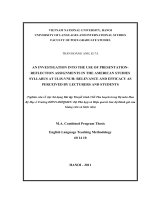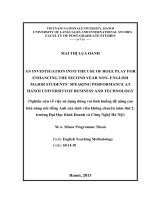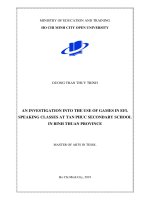An investigation into the use of authentic materials in developing reading comprehension ability for non english majored students at university of technical education in ho chi minh city
Bạn đang xem bản rút gọn của tài liệu. Xem và tải ngay bản đầy đủ của tài liệu tại đây (21.73 MB, 152 trang )
<span class="text_page_counter">Trang 1</span><div class="page_container" data-page="1">
<b>VIETNAM NATIONAL UNIVERSITY – HO CHI MINH CITY </b>
UNIVERSITY OF SOCIAL SCIENCES AND HUMANITIES FACULTY OF ENGLISH LINGUISTICS AND LITERATURES
<b>AN INVESTIGATION INTO </b>
<b>THE USE OF AUTHENTIC MATERIALS IN DEVELOPING READING COMPREHENSION ABILITY </b>
<b>FOR NON-ENGLISH MAJORED STUDENTS AT UNIVERSITY OF TECHNICAL EDUCATION </b>
<b>IN HO CHI MINH CITY </b>
<b>A thesis submitted in partial fulfillment of the requirements for the degree of Master of Arts (TESOL) </b>
<b>Submitted by PHAN TH M</b>ị <b>ỵ THI N</b>ị
<b>Supervisor Lấ TH THANH, </b>Þ <b>Ph.D. </b>
<b>HO CHI MINH CITY - DECEMBER 2013 </b>
</div><span class="text_page_counter">Trang 2</span><div class="page_container" data-page="2"><b>STATEMENT OF AUTHORITY </b>
<b>I hereby certify that this thesis entitled “AN INVESTIGATION INTO THE </b>
<b>USE OF AUTHENTIC MATERIALS IN DEVELOPING READING </b>
<b>STUDENTS AT THE UNIVERSITY OF TECHNICAL EDUCATION IN HO CHI MINH CITY” is the result of my own work except the extraction and </b>
citation in the references.
This thesis has not been previously submitted for the candidature of any degrees or diplomas in any other institution.
Ho Chi Minh City, December 24<small>th</small>
,
2013<b>PHAN TH M </b>ị <b>ỵTHI N</b>ị
</div><span class="text_page_counter">Trang 3</span><div class="page_container" data-page="3">ii
<b>RETENTION AND USE OF THE THESIS </b>
I hereby state that I, PHAN THI MY THIEN, being the candidate for the degree of Master in TESOL, accept the requirements of the University relating to the retention and use of Master’s Theses deposited in the Library.
In terms of these conditions, I agree that the original copy of my thesis deposited in the Library should be accessible for purposes of study and research in accordance with the normal conditions established by the Library for the care, loan and reproduction of theses.
Ho Chi Minh City, December 2013 Signature: Name: <b>PHAN THI MY THIEN</b>
</div><span class="text_page_counter">Trang 4</span><div class="page_container" data-page="4">3
<b>ACKNOWLEDGEMENTS </b>
The thesis has been completed with the help of all people who helped me to shape this thesis, and without whom this thesis would have never been finished.
First and foremost, I would like to express my deepest gratitude to my supervisor, Ms. Le Thi Thanh, PhD for her patience, enthusiasm, encouragement, careful instructions and insights into pedagogical methodology and language competence.
Furthermore, I am very grateful to all teachers and students at the Ho Chi Minh City University of Technical Education for their assistance of providing data analysis.
Besides, I am extremely indebted to all lecturers of the TESOL graduate program at the University of Social Sciences and Humanities for their attentiveness and helpful instruction during the course from the year 2009 to 2012.
In addition, I hope to send many thanks to my classmates of TESOL 09 for their support, friendship and valuable recommendations during the course.
Finally, an extra special appreciation goes to my family who always encourage and facilitate me to conduct the study. In particular, my toddler son is the strongest motivation for me to pursue the thesis.
</div><span class="text_page_counter">Trang 5</span><div class="page_container" data-page="5">4
<b>ABSTRACT </b>
This thesis aimed at investigating the current difficulties in teaching and learning reading at the UTE as well as teachers’ and students’ attitudes towards the use of authentic materials in reading class. In addition, it also targeted at finding out the advantages as well as disadvantages of authentic materials when being used in reading class.
245 non-English majored students from four General English 3 classes were asked to complete the two sets of questionnaires including pre-survey and post- survey questionnaires to students at the beginning and the nearly end of the course, respectively. Ten teachers who also participated in the study through questionnaires to teachers at the thirteenth week of the semester. The data collected was analyzed and conducted by measures of counts, means and percentages. Class observation was also conducted within the course to find out the potential difficulties as well as satisfaction of the application of authentic materials.
The findings from the study indicated that most participant students encountered the following obstacles and difficulties in learning reading, namely, low learning motivation, limited language knowledge, and lack of reading strategies. Nevertheless, thanks to the suitable teaching techniques and educative ways, students have lessened their obstacles and become interest in reading English. Particularly, the results of the study showed that most teachers and students have favorable attitudes towards the use of authentic materials. In general, both teachers and students realized the benefits of authentic materials bringing to them with carefully selection and use from the teachers so as to make full use of the text types.
</div><span class="text_page_counter">Trang 6</span><div class="page_container" data-page="6">Table of contents ... ….iv
List of tables... ... viii
List of charts ... ….ix
List of abbreviations ...x
<b>CHAPTER I INTRODUCTION ...1 </b>
1.1. Background to the study ... 1
1.1.1. Rationale. ...1
1.1.2. Current problems associated with teaching reading at UTE ...2
1.1.3. Teaching and learning English at UTE ...3
1.1.4. Teaching and learning Reading of General English 3 at UTE ... 4
1.1.5. Material description ... 4
1.1.5.1. Objectives of “Starter TOEIC” ...5
1.1.5. 2. Reading comprehension section ...6
1.2. The objectives of the study ... 6
1.3. Research question...7
1.4. Significance of the study ... 7
1.5. Limitation and Delimitation... 7
1.6. The organization of the thesis ...8
<b>CHAPTER II LITERATURE REVIEW ...9 </b>
2.1. The Nature of Reading Comprehension ...9
2.1.1. What is reading comprehension ...9
2.1.2. Reading Purposes ... 10
2.1.3. Reading Strategies ... 12
</div><span class="text_page_counter">Trang 7</span><div class="page_container" data-page="7">2.4. Authentic materials and authenticity ... 18
2.4.1. Authenticity in Language Learning... 18
2.4.2. What are authentic materials/texts ... 20
2.4.3. Types of Authentic materials ... 22
2.4.3.1. Newspaper articles and magazines ... 22
2.4.3.2. Application (Job, CV, Class) ... 23
2.4.3.3. Leaflet, brochures ... 23
2.4.3.4. Timetables (Train, airport) ... 24
2.4.3.5. Program (TV listing, cinema, theatre) ... 24
2.4.3.6. Fictions and creative writing (story, poems, songs) ... 24
2.4.4. Choosing and Using authentic materials in Language classroom ... 25
2.5. Authentic materials as a tool to teach reading comprehension ... 26
2.5.1. Advantages of using authentic materials in teaching reading ... 27
2.5.2. Disadvantages of using authentic materials in teaching reading ... 30
2.6. Previous researches in related fields ... 31
</div><span class="text_page_counter">Trang 8</span><div class="page_container" data-page="8">3.5.1.1.1. Pre-survey questionnaires to students... 39
3.5.1.1.2. Post-survey questionnaires to students ... 40
4.1.1. Results from teachers’ questionnaires ... 45
4.1.1.1. Teachers’ choices of using authentic materials... 45
4.1.1.2. Teachers’ attitudes towards teaching reading comprehension through authentic materials ... 47
4.1.1.2.1. Results of Teachers’ Survey on Question 6 ... 47
4.1.1.2.2. Results of Teachers’ Survey on Question 7 ... 48
4.1.2. Results from students’ questionnaires ... 49
4.1.2.1. Results from pre-survey questionnaires to student ... 49
4.1.2.1.1. Students’ average grades in English and reading comprehension at the final test of GE-2... 49
4.1.2.1.2. Students’ perception and attitudes to reading ... 51 4.1.2.1.3. Students’ expectation and suggestions for further reading class
</div><span class="text_page_counter">Trang 9</span><div class="page_container" data-page="9">8
improvement ... 54
4.1.2.2. Choosing authentic materials ... 57
4.1.2.3. Results from post-survey questionnaires to student ... 57
4.1.2.3.1. Students’ perception of their current reading comprehension abilities ... 58
4.1.2.3.2. Students’ attitude towards the current reading classes of GE-3 ... 59
4.1.2.3.3. Students’ attitudes towards the authentic reading texts used by teachers ... 61
4.1.2.3.4. Students’ viewpoints on the use of authentic materials... 62
4.1.2.3.5. Students’ difficulties in learning reading ... 65
4.1.3. Results from the Class Observation ... 66
4.1.3.1. Classroom Environment ... 66
4.1.3.2. Reports on Class Observation ... 67
4.2 Findings and Discussion of Results ... 69
4.2.1. Current situation of teaching and learning reading comprehension at the UTE ... 69
4.2.2. Students’ attitude toward the application of authentic materials ... 71
4.2.3. Teacher’s attitude toward the application of authentic materials ... 72
4.2.4. The application of authentic materials at the UTE ... 74
4.2.5. Suggestions for using authentic materials to teach reading comprehension for English non-majored students... 74
4.3. Chapter summary ... 75
<b>CHAPTER V CONCLUSION AND RECOMMENDATIONS ... 76 </b>
5.1. Conclusion ... 76
5.2. Recommendations ... 79
5.2.1. Recommendations for teachers of English ... 79
5.2.2. Recommendations for students ... 81
5.3. Limitattions and Suggestions for further research ... 82
</div><span class="text_page_counter">Trang 10</span><div class="page_container" data-page="10">9
APPENDIX 1B Pre-survey questionnaires to Students (English version) ... 89
APPENDIX 2A Post-survey questionnaires to Students (Vietnamese version) .. ……90-91 APPENDIX 2B Post-survey questionnaires to Students (English version)... ……92-93 APPENDIX 3A Questionnaires to Teachers (Vietnamese version) ... ……94-95 APPENDIX 3B Questionnaires to Teachers (English version) ...96-97 APPENDIX 4 Class Observation Sheet ... .98
APPENDIX 4A CLASS OBSERVATION SHEET 1...99-100 APPENXIX 4B CLASS OBSERVATION SHEET 2 ...101-102 APPENXIX 4C CLASS OBSERVATION SHEET 3 ...103-105 APPENDIX 4D CLASS OBSERVATION SHEET 4 ...106-107 APPENDIX 5A DESCRIPTION AND SUMMARY OF “STARTER TOEIC”...108-112 APPENDIX 5B COURSE SYLLABUS WITH AUTHENTIC MATERIALS...113-116 APPENDIX 6.1. WHAT IS THE BEST AGE TO GET MARRIAGE ...117-118 APPENDIX 6.2. AT THE AIRPORT ...119-120 APPENDIX 6.3. ENTERTAINMENT ...121-122 APPENDIX 6.4.1. HEATHY AND UNHEALTHY FOOD ...123-124 APPENDIX 6.4.2. IS THIS THE MOST DANGEROUS RESTAURANT IN THE WORLD? ... 125
APPENDIX 6.5. LESSONS LEAVE NO TIME FOR PLAY IN SEOUL...126-127 APPENDIX 6.6 A LIFE OF LEISURE ... 128
APPENDIX 6.7. ADVERTISEMENT AND JOB ANNOUNCEMENT ... 129
APPENDIX 6.8. MUSIC PERFORMANCE... 130
APPENDIX 6.9. ART PERFORMANCE ... 130
APPENDIX 6.10. BOSTON MARATHON...131-132 APPENDIX 6.11. NEW FOODS ...133
APPENDIX 6.12. SCIENCE AND TECHNOLOGY ...134
</div><span class="text_page_counter">Trang 11</span><div class="page_container" data-page="11"><b>LIST OF TABLES </b>
<b>Pages Table 1.1. First stage of three General English courses for non-English majored </b>
students at the UTE ...3
<b>Table 2.1 Successful Extensive Reading ... 15 </b>
<b>Table 3.1 Timeline of investigation ... 35 </b>
<b>Table 3.2 Details of English 3 classes’ timetable ...36 </b>
<b>Table 3.3 Demographic data of teacher participants ... 37 </b>
<b>Table 3.4 Demographic data of student participants ... 38 </b>
<b>Table 3.5 Details of four class observations...44 </b>
<b>Table 4.1 Types of authentic materials teachers have used for teaching Reading ... 46 </b>
<b>Table 4.2 Advantages of using authentic materials in teaching reading comprehension .... 47 </b>
<b>Table 4.3 Disadvantages of using authentic materials in teaching reading </b> comprehension ... 48
<b>Table 4.4 Students’ average grade in English and reading comprehension at the final </b> test of GE-2 ... 50
<b>Table 4.5 Students’ attitudes to the difficulty of reading skill ... 52 </b>
<b>Table 4.6 Students’ expectations of reading text types... 55 </b>
<b>Table 4.7 Students’ suggestions for further reading class improvement ... 56 </b>
<b>Table 4.8 Case Summary of students’ suggestions for reading class improvement ... 57 </b>
<b>Table 4.9 Students’ attitudes to GE-2 reading classes versus students’ attitudes to GE- </b> 3 reading classes ... 60
<b>Table 4.10 Students’ perception of reading texts in starter TOEIC versus students’ </b> perception of authentic reading texts ... 62
<b>Table 4.11 Students’ attitude towards the use of authentic materials ... 63 </b>
<b>Table 4.12 Types of authentic materials that students like to read... 64 </b>
<b>Table 4.13 Students’ difficulties in learning reading ... 65 Table 4.14. Sections of Class Observations ... 67-68 </b>
</div><span class="text_page_counter">Trang 12</span><div class="page_container" data-page="12"><b>Table 4.15 Level of students’ attitudes ... 73 </b>
<b>Table 5.1 Strength of authentic materials in teaching and learning reading </b> comprehension ... 79
<b>LIST OF FIGURES Pages Figure 2.1 Levels of processing in reading comprehension... 17 </b>
<b>Figure 2.2 Text as object ... 28 </b>
<b>Figure 2.3 Text as process ... 28 </b>
<b>Figure 4.1 Types of authentic materials that teachers have used for teaching Reading... 46 </b>
<b>Figure 4.2 Students’ average grade in English at the final test of GE-2 ... 49 </b>
<b>Figure 4.3 Students’ average grade in Reading Comprehension at the final test of GE- </b> 2... 49
<b>Figure 4.4 Student’s viewpoints on the role of reading skill in foreign language </b> learning ... 51
<b>Figure 4.5 Students’ attitudes to the difficulty of reading skill... 52 </b>
<b>Figure 4.6 Student’s attitudes to the previous reading classes (GE-2) ... 53 </b>
<b>Figure 4.7 Student’s attitudes to reading texts in the Starter TOEIC ... 54 </b>
<b>Figure 4.8 Students’ self-assessment of their current reading comprehension abilities... 58 </b>
<b>Figure 4.9 Students’ perception of reading comprehension difficulties (%) ... 59 </b>
<b>Figure 4.10 Students’ attitude to the current reading classes of GE-3 ... 60 </b>
<b>Figure 4.11 Students’ attitudes to the authentic materials used in reading classes of </b> GE-3 ... 61
</div><span class="text_page_counter">Trang 13</span><div class="page_container" data-page="13">xii
<b>LIST OF ABBREVIATIONS </b>
AM : Authentic Materials B.A : Bachelor of Art
EFL : English as a Foreign Language ELA : English Language Acquisition ELT : English Language Teaching ESL : English as a Second Language ESP : English for Specific Purposes ETM : English Teaching Materials FFL : Faculty of Foreign Languages GE : General English
GE-2 : General English 2 GE-3 : General English 3 M.A : Master of Art
MOET : Ministry of Education and Training HCMC : Ho Chi Minh City
PhD : Doctor of Philosophy SL : Second Language
TESOL : Teaching English to Speakers of Other Languages TOEIC : Test of English for International Communication UTE : University of Technical Education
USSH : University of Social Sciences and Humanities VNU : Vietnam National University
</div><span class="text_page_counter">Trang 14</span><div class="page_container" data-page="14">1
<b>CHAPTER 1 INTRODUCTION </b>
This chapter begins with the discussion of the general background of the study as well as the reasons for choosing the topic. It then presents the current problems associated with teaching and learning reading skill. In addition, the study focuses on the objectives and the significance of the thesis. Besides, some limitations of the study are also taken into consideration.
<b>1.1. BACKGROUND OF THE STUDY 1.1.1. Rationale </b>
It is widely acknowledged that reading plays an important role in language acquisition. It is the process of recognition, interpretation, and perception of written materials. According to Richard and Renadya (2002: 273), in most EFL situations, the ability to read in a foreign language is that all students want to acquire.
In the light of reading as an active process, it is really important to draw students’ attention to learning reading in language classroom. Once readers read a text, they need to bring their own experience and knowledge to interpret the text. Therefore, we can say reading is a tool to touch a successful life. Reading serves a variety of pedagogical purposes such as: reading for information and entertainment, for their careers or for study purpose. Moreover, the ability to read enables us to access to the real world, to get more knowledge and to enjoy daily things. Likewise, Blake (1989:1) stated that reading is one of our keys to the world.
Nowadays, along with the development and modernization of information technology, students are overwhelmed by internet, films, cable TV, apps, etc. Thereby, they seem less interested in reading a book, especially, book with pedagogical purposes. Indeed, students do not read or do not like to read at all.
To increase students’ motivation, Davies and Widdowson (1974:172) cited a suggestion in Routledge (2009:29) as a contribution to dealing with the above situation that
</div>








